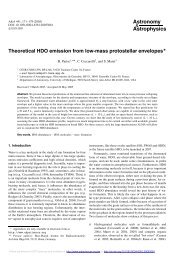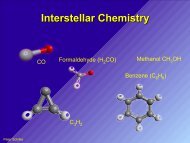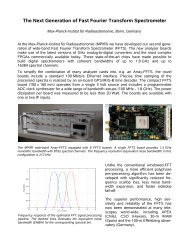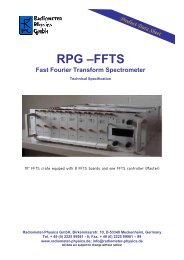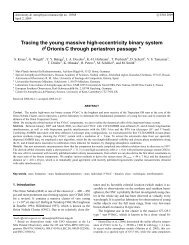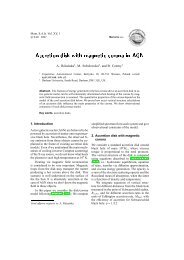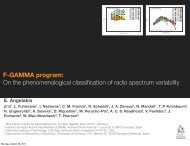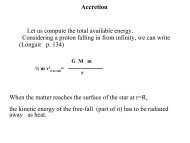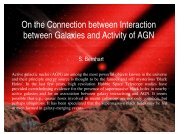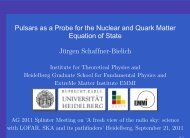APEX - The Atacama Pathfinder Experiment APEX - The Atacama ...
APEX - The Atacama Pathfinder Experiment APEX - The Atacama ...
APEX - The Atacama Pathfinder Experiment APEX - The Atacama ...
You also want an ePaper? Increase the reach of your titles
YUMPU automatically turns print PDFs into web optimized ePapers that Google loves.
<strong>APEX</strong> - <strong>The</strong> <strong>Atacama</strong> <strong>Pathfinder</strong> <strong>Experiment</strong><br />
Presentation of the Project<br />
Rolf Güsten<br />
for the<br />
<strong>APEX</strong> Project Team<br />
Bonn 21.10.05<br />
R.Güsten
<strong>The</strong> <strong>APEX</strong> Consortium<br />
<strong>APEX</strong> is a collaboration between the<br />
Max-Planck-Institut für Radioastronomie (MPIfR),<br />
Onsala Space Observatory (OSO), and<br />
OSO<br />
21%<br />
Chile<br />
10%<br />
ESO<br />
24%<br />
MPG<br />
45%<br />
the European Organisation for Astron. Research in the Southern Hemisphere<br />
<strong>The</strong> telescope was designed and constructed by VERTEX Antennentechnik,<br />
under contract by MPIfR.<br />
<strong>The</strong> Operation of <strong>APEX</strong> is entrusted to ESO.<br />
Bonn 21.10..05<br />
R.Güsten
Project History: some basic facts<br />
Short Project History:<br />
• Memorandum of Understanding between the Partners June 01<br />
• contract with Vertex Antennentechnik 02.07.01<br />
• start construction on high site spring 03<br />
• start commissioning, operation of first submm receiver spring 04<br />
• successfull commissioning of the antenna 28.06.05<br />
• facility science verificaton July 05<br />
• begin of regular science operation of facility August 05<br />
Bonn 21.10..05<br />
R.Güsten
<strong>The</strong> <strong>APEX</strong> base in Sequitor<br />
<strong>The</strong> base in Sequitor is situated inside the oasis of San Pedro (2400m)<br />
<strong>The</strong> buildings consist of a control room/office/laboratory building,<br />
16 dormitories, a cafeteria, a meeting room and a storage area.<br />
Electrical power is generated by two generators<br />
Water is provided through the local water supply from San Pedro.<br />
<strong>The</strong> base has a gasoline station, solar power heaters for hot water<br />
and a sewage treatment plant.<br />
Bonn 21.10..05<br />
L-Å Nyman
the dormitories<br />
footpath to office building<br />
offices/laboratories<br />
Bonn 21.10..05<br />
meeting rooms
<strong>The</strong> Telescope Site at Chajnantor<br />
the <strong>Atacama</strong> <strong>Pathfinder</strong> <strong>Experiment</strong> telescope<br />
Containers, incl. control room, laboratories, kitchen, (dorm) & storage<br />
Power is provided by two generators (450 kVA each)<br />
Weather station & microwave link to the base in Sequitor<br />
Location Llano de Chajnantor, 50 km East of San Pedro de <strong>Atacama</strong><br />
Coordinate latitude 23º00′20.8″ South<br />
longitude 67º45′33.0″ West<br />
elevation 5107m<br />
Bonn 21.10..05<br />
R.Güsten
<strong>The</strong> <strong>APEX</strong> Telescope: key facts<br />
Diameter<br />
Total mass<br />
Surface accuracy<br />
Pointing accuracy<br />
Manufacturer<br />
12m<br />
125 t<br />
17 µm rms<br />
2” rms over sky<br />
Vertex Antennentechnik<br />
Bonn 21.10..05
Telescope Commissioning: surface adjustment<br />
Goal: adjust the surface of the main dish to better than 20µm rms<br />
Steps towards the “perfect” telescope<br />
requirement: deviation from perfect parabola (12m) less than ¼ the<br />
thickness of the average human hair!<br />
Commissioning Objectives:<br />
• verify that the surface of the main dish can be adjusted to specifications<br />
spec: „better than 20 µm rms“<br />
• confirm that this surface precision can be maintained<br />
under „normal“ operating conditions (in particular vs. elevation)<br />
• verify that telescope can be tracked and pointed to required accuracy<br />
spec: 2“ rms blind on sky<br />
Bonn 21.10..05<br />
R.Güsten
Telescope Surface Adjustment I<br />
after a series of iterations of adjustment main dish adjusted to 14-15 µm<br />
Bonn 21.10..05<br />
R.Güsten
Telescope Surface Adjustment II<br />
transmitte<br />
r<br />
preloaded<br />
Summary of the April 2005 holography:<br />
• the surface has been set to 14-15 µm rms accuracy (night time conditions)<br />
with an extremely stable measurement set-up (repeatability: 5.5 µm)<br />
• environmental conditions (thermal gradients at daytime and during<br />
sunrise/set) will degrade the surface by a few µm<br />
• gravitational deformation will degrade the surface at elevations ≠13.8 deg<br />
pre-load the surface settings to El 50 deg (FE Model)<br />
By pre-loading the surface, antenna is now optimized for astronomical observations<br />
Bonn 21.10..05<br />
R.Güsten
Telescope: Performance on Sky I<br />
Goal: verify telescope performance by astronomical measurements<br />
FLASH receiver<br />
Jupiter at 812 GHz<br />
Beam quality: exceptionally clean beam, low sidelobes, diffraction limited optics<br />
Bonn 21.10..05<br />
R.Güsten
Telescope: Performance on Sky II<br />
Goal: verify coupling efficiency by astronomical measurements<br />
drift scan at ν=462 GHz across Venus<br />
Jupiter & Mars at 812 GHz<br />
Gain curve: after pre-loading the dish „flat“ vs. elevation (gravity)<br />
Coupling efficiencies: consistent with surface rms
Telescope: Pointing<br />
Goal: blind pointing over the sky better than 2 arcsec<br />
Remind: the beam at 1 THz observing frequency is 6 arcsec only<br />
Optical Pointing: spec has been achieved and verified (ca. 2“)<br />
Radio Pointing: optimization ongoing (2-3“), with room for improvements<br />
Bonn 21.10..05<br />
R.Güsten
<strong>APEX</strong> - <strong>The</strong> <strong>Atacama</strong> <strong>Pathfinder</strong> <strong>Experiment</strong><br />
has been successfully commissioned and<br />
has commenced regular scientific operation in August 2005<br />
the world’s largest submm telescope is operational
Bonn 21.10..05<br />
<strong>APEX</strong> instrumentation: today & tomorrow
<strong>The</strong> <strong>APEX</strong> Instrumentation<br />
Bolometers<br />
MOU commitments / PI status<br />
• LABOCA-1: 295-channel at 870 µm (MPIfR, Bochum U., IPHT Jena) 03/06<br />
• 37-channel at 350 µm (MPIfR) Summer 06<br />
• 324-channel at 1.4/2 mm for Sunyaev-Zel'dovich survey (UCB, MPIfR) ongoing<br />
Heterodyne<br />
• 183 GHz water vapour radiometer (MPIfR) Operational<br />
• 210-270 GHz (OSO)<br />
• 270-375 GHz (OSO) Prel. del: 07/05, full suite 12/06<br />
• 375-500 GHz (OSO)<br />
Full suite of facility mixers: only 12/06<br />
• 460/810 GHz dual channel First High-frequ. Light Apex workhorse Submm Heterdyne 05/04, upgrade Rx (MPIfR,PI) 02/06<br />
• CHAMP + 600-720/790-920 GHz, 2×7-elements with MACS (MPIfR, 05/06 PI)<br />
• FIR receivers: up to 1.5 THz = 200 micron (OSO, KOSMA, CfA)<br />
11/05<br />
Spectrometer / Backend<br />
∙ IF Board: & autocorrelator be replaced (upgraded by MPIfR old SEST buildcorrelator) new IF and (ESO/OSO) FFTS<br />
Software<br />
Bonn 21.10..05<br />
Commiss. 03/06 failed<br />
R.Güsten
<strong>APEX</strong> Instrumentation: FLASH<br />
• a dual channel heterodyne instrument (PI)<br />
• operating in the 460 & 810 GHz atm. window<br />
– simultaneous measurements in both bands<br />
– tuning range: 420-500; 790-830 GHz<br />
(not easy to tune)<br />
– noise performance: 150-250 K<br />
350-450 K<br />
– Intermediate frequeny: 2-4 & 4-8 GHz, rsp.<br />
FLASH is a collaboration with SRON/Groningen<br />
Bonn 21.10..05<br />
R.Güsten
<strong>APEX</strong> Instrumentation: CHAMP+ overview<br />
• 2 x 7 pixel heterodyne instrument<br />
• operating in the 660 & 850GHz atm. window<br />
– simultaneous measurements in both bands<br />
– large tuning band for both frequency bands<br />
– very low losses cold optics<br />
• Champ+ will be the ultimate high-frequency<br />
mapping machine for <strong>APEX</strong><br />
• Operated with MACS (32x 1024 /1 GHz max)<br />
Bonn 21.10..05<br />
CHAMP+ is a collaboration with SRON/Groningen<br />
R.Güsten
<strong>APEX</strong> Instrumentation: CHAMP+ key facts<br />
Frequency range<br />
Noise performance<br />
IF-bandwidth<br />
Beam (FWHM)<br />
Low Frequency Array<br />
620-720GHz<br />
< 100 K<br />
4-8 GHz<br />
9‘‘ arcsec<br />
High Frequency Array<br />
780-950GHz<br />
< 300 K<br />
4-8 GHz<br />
7‘‘ arcsec<br />
Low loss cold optics<br />
Single Sideband Filter<br />
Fast Frequency switch<br />
implemented<br />
implemented<br />
implemented<br />
Bonn 21.10..05<br />
R.Güsten
<strong>APEX</strong> FFT Spectrometer<br />
• Bandwidth: 2 x 1 GHz<br />
1 x 2 GHz (still experimental)<br />
• Channels: 16384 frequency channels<br />
• Resolution: 61 kHz per channel<br />
• Sampler: 8-bit (max. dynamic range: 48 dB)<br />
• Stability: ~5000 sec Allan Time<br />
• Safe to use at high altitude (e.g. <strong>APEX</strong> at 5100 meter)
<strong>APEX</strong>: outlock into 2006 operation<br />
Major Milestones for 2006:<br />
• wobbler installation and commissioning:<br />
• „final“ holography with new subreflector<br />
February<br />
March<br />
• receiver installations and commissioinings:<br />
• Laboca 1<br />
• SZ experiment<br />
• CHAMP+ /MACS<br />
• new facility IF and FFT spectrometers<br />
• re-start science operation(after winter)<br />
April<br />
(ongoing)<br />
June<br />
March<br />
April+<br />
Bonn 21.10..05<br />
R.Güsten



